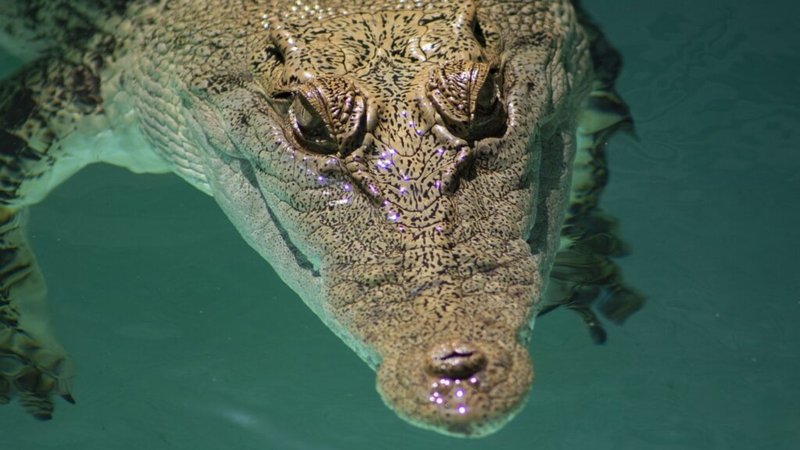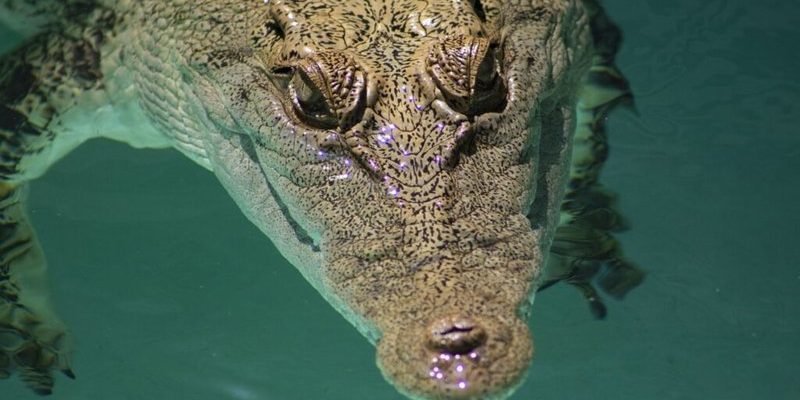
Imagine a creature that can live both in freshwater and saltwater, almost like a superhero of adaptability in the animal kingdom. They can be found in rivers, estuaries, and coastal regions, proving that they can conquer various environments. Let’s dive into the world of the saltwater crocodile and uncover some surprising truths about this remarkable species.
1. They’re the Largest Living Reptiles
Saltwater crocodiles are the biggest reptiles on our planet. We’re talking about some serious size here! Adult males can grow up to 20 feet long and weigh over a ton. To put that in perspective, that’s longer than a small car. These massive reptiles have a muscular build, which helps them overpower prey effortlessly.
The impressive size isn’t just for show; it plays a role in their hunting strategy. A larger crocodile can take down bigger prey, from fish to mammals, and even other reptiles. It’s a classic case of “the bigger, the better” when it comes to survival in the wild.
2. They Have an Unmatched Bite Force
When it comes to bite force, saltwater crocodiles hold the record. Research suggests they can exert a bite force of over 3,700 pounds per square inch. That’s enough to crush bones—and just about anything else in their jaws. Honestly, even the toughest materials would struggle against such a force.
This tremendous power serves a purpose. When saltwater crocodiles hunt, they need to hold onto slippery prey. Those powerful jaws can quickly clamp down on fish or mammals, making it hard for them to escape. So, if you’re thinking about challenging a crocodile in a bite competition, forget it!
3. Their Range is Impressive
Saltwater crocodiles have the largest distribution of any crocodile species. They can be found in parts of Southeast Asia, northern Australia, and even the islands of the Pacific. This adaptability to different habitats helps them thrive in a variety of environments.
They can swim long distances in saltwater, allowing them to migrate between different regions. Some saltwater crocodiles have been recorded swimming over 900 miles at sea. That’s a serious road trip for a reptile! This capability not only helps them find food but also allows them to escape from threats and find new territories.
4. They Can Regulate Their Body Temperature
Like many reptiles, saltwater crocodiles are ectothermic, which means they rely on external sources to regulate their body temperature. However, they have some impressive techniques up their sleeves. When it’s hot, they can bask in the sun to warm up, but when temperatures rise too high, they’ll plunge into cool water to cool off.
This behavior is essential for their survival. By effectively managing their body heat, they can be more active during hunting hours and conserve energy when it’s too cold or too hot. They’re like nature’s thermostat, adjusting to keep themselves comfortable and ready for action.
5. They Have a Unique Feeding Behavior
Saltwater crocodiles are known for a hunting technique called “death roll.” This behavior involves grabbing their prey and spinning rapidly in the water. The goal? To tear apart their catch or drown it. You might think it sounds brutal, and it is! But it ensures that they get the most out of their meal, especially when dealing with larger prey.
This feeding strategy also highlights their intelligence. Saltwater crocodiles learn from their experiences and adapt their hunting techniques based on what works best for them. They don’t just rely on brute strength; they’re strategic thinkers when it comes to filling their bellies.
6. They’re Excellent Swimmers
Saltwater crocodiles are built for life in water. Did you know they can hold their breath for over an hour? This amazing ability is useful when they’re hunting or hiding from danger. Their streamlined bodies and powerful tails allow them to glide through the water with little effort.
Even more impressive, they can swim at surprising speeds for short bursts. If they need to chase down prey, they can unleash a quick surge of energy to close the gap. So, if you ever see a saltwater crocodile in the water, you might want to keep your distance—these creatures are masters of their aquatic domain.
7. They Communicate in Unique Ways
Saltwater crocodiles may seem stoic, but they have a complex system of communication. They use a variety of vocalizations, body language, and even low-frequency sounds to convey their feelings. When they’re agitated, they might emit hissing sounds, and during mating season, you can hear their loud bellows echoing through the waterways.
While we might not understand their “language,” it’s clear they have a lot to say. These communication methods help maintain their territory and attract mates. Think of it as their version of social networking!
8. Saltwater Crocodiles Are Incredible Parents
You might not think of crocodiles as nurturing, but saltwater crocodiles show surprising parental care. Females build nests for their eggs and fiercely guard them until they hatch. After the hatchlings emerge, they often help them reach the water, ensuring they get a good start in life.
While it’s not as warm and fuzzy as a bird’s nest, this behavior indicates a strong instinct to protect their young. The female crocodile remains vigilant, warding off potential threats to her brood, displaying a softer side that many don’t expect from such fierce predators.
9. They Play a Vital Role in Their Ecosystem
Saltwater crocodiles are not just formidable predators; they’re also essential to maintaining the balance of their ecosystems. By controlling the population of various species, they help keep the environment healthy. For instance, by preying on sick or weak animals, they ensure that the strongest genes survive in the population.
This may sound harsh, but it’s nature’s way of promoting a balanced habitat. Without saltwater crocodiles, fish and other animals could overpopulate, leading to a decline in vegetation and disrupting the entire system. So, in many ways, they’re like nature’s cleanup crew.
10. They’re at Risk Due to Human Activity
Unfortunately, saltwater crocodiles face numerous threats due to human activities. Habitat destruction, poaching, and climate change are major issues impacting their populations. As coastal areas develop and more land is cleared for agriculture, these magnificent reptiles lose their homes.
Conservation efforts are underway in many regions to help protect saltwater crocodiles, but more awareness is needed. Understanding their role in the ecosystem is crucial to ensuring their survival for future generations. It’s essential that we coexist with these remarkable creatures, appreciating them for what they contribute to our world.
In conclusion, the saltwater crocodile is so much more than just a fearsome predator. They’re fascinating, complex animals that play a vital role in their ecosystems while showcasing some incredible adaptations. Next time you think about these reptiles, remember they have unique traits and stories that make them truly special. Let’s work together to ensure they thrive in the wild for years to come!

